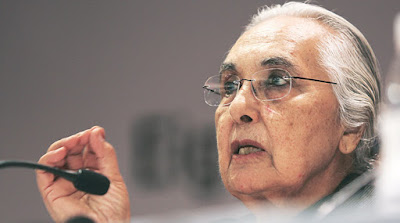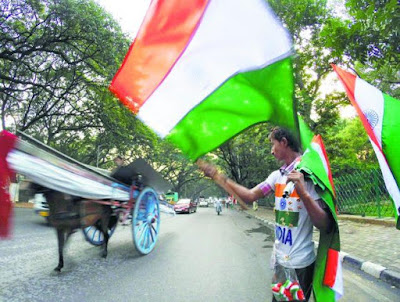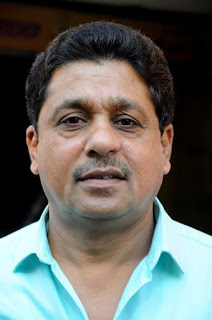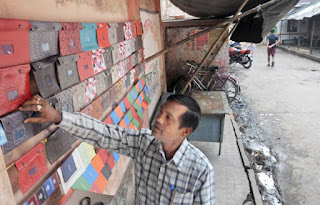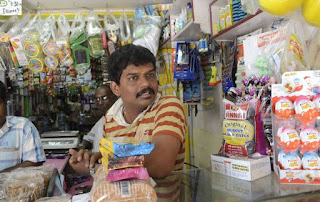Thapar said clearly those who enforced this found it greatly to their advantage to push entire communities into permanent exclusion so much so that successive generations too were decreed untouchable.
Written by Seema Chishti | New Delhi | Updated: April 15, 2016 8:56 am
Romila Thapar in New Delhi on Thursday. (Express Photo by Anil Sharma)
Babasaheb B R Ambedkar, who she had been reading “more and more over the years”, had contributed tremendously to her understanding of the abomination untouchability system in Hinduism, eminent historian and Professor Emerita at JNU, Romila Thapar, said while delivering the eighth Dr BR Ambedkar lecture, organised by Ambedkar University of Delhi, on Thursday.
In a talk lasting over an hour-and-a-half, apart from select questions she fielded, Thapar said a stratified caste-based society has existed in India for millennia, but the appearance of untouchability probably can be dated to more than two millennia ago, when the word ‘asprishya’ makes an appearance and the Chandals were discussed.
Speaking on “permanently excluding” an entire set of people which made untouchability unique, and even worse than slavery (“because under some conditions slaves could become free and citizens”), Thapar said clearly those who enforced this found it greatly to their advantage to push entire communities into permanent exclusion so much so that successive generations too were decreed untouchable.
The central premise of her talk — ‘Rethinking Civilisation as History’ — was on the limitations of how the term ‘Civilisation’ was used, with a focus on “cultural singularity” to discuss or understand events, creating the idea of ‘the other’ or a mistaken ‘clash of civilisation’ to define a people. She began by elaborating on how the phrase civilisation came about, was of European origin, seeking to define others as either savages or barbarians. Citing the creation of the ‘barbarous’ by the Greece or the ‘Mlechh’ or ‘das’ idea of the ‘other’ by Brahmins in Vedic times, Thapar dwelt on colonial history, 18th century European ideas and its impact on how India was seen by them and how Indians see themselves to date.
Thapar said that the term was used to denote a system with singularity of language, religion, fixed territory and a set of ideas. Eventually, when the term civilisation was used to denote the history of a particular time, it ended up representing the life of the dominant group at any point of time. So, Thapar argued, whenever ‘civilisation’ was used to talk about India, it did not fully represent India either fairly or accurately.
On territory, Thapar elaborated on how a ‘section of people’, arguing for Indian civilisation over a fixed territory, usually, following the description of colonial historians like James Mill, referred to British India as the boundaries, not speaking of Jambudwipe, Aryavarta or Al-Hind as alternative boundaries; “but even that changed so dramatically, that binding Indian civilisation between fixed boundaries was meaningless.”
Thapar spoke of the importance of culture at the frontiers of the boundaries and how it influenced things inside, but that having received inadequate attention so far.
On one religion, Thapar elaborated how for millennia, the wide spectrum of sects, between the Brahmans and Shramans or the Astiks and Nastiks and aajivikas defined a much richer variety of faith. But after colonial European historians came to India and put all non-Muslim and Christian faiths under the ‘Hindu’ label, it was an oversimplification of what was happening here.
She said dialogue between various sects between the Brahmans and Shramans resulted in each one calling the other ‘Pashandas’, or frauds, and levels of intolerance were on display with reference to Buddhism and castes and sects treated as lower and untouchable. In a statement significant with debates today about portrayal of ancient India as tolerant, Thapar said: “The degree of tolerance and ideas of non-violence in the past need to be re-examined.”
On language, too, Thapar spoke of how high-quality debates and arguments took place in Prakrit, which remained a very popular but ignored language as ancient India is characterised as having just a Sanskrit base, ignoring both Prakrit and Pali, and of course languages in peninsular India. While Sanskrit was also the language which the elites and several royals patronised, with a rich repository of literature and philosophy, it was not the only language of the land.
Thapar emphasised on interactions between cultures and across boundaries and even high, dominant cultures executed by often smaller and less dominant castes, such as artisans and craftsmen, about whose interaction we know little. She spoke of the importance of “interface between what see as distinct cultures, which civilisation is about and not separation”. She spoke of co-mingling of people, engagement and cultures who spoke to each other as agents of change and growth, internally and across boundaries accepted (mistakenly) as static and eternal that often generated the maximum activity.
Speaking before her, the Vice Chancellor of AUD, Dr Shyam Menon spoke of plans in the university to institute a Chair for Dr BR Ambedkar Studies and, soon, to have a Centre for Critical Ambedkar Studies. Menon spoke of how the 125th anniversary of Ambedkar had coincided with difficult times for ideals Ambedkar held close to him. “We are seeing distressing times when there is the silencing of rationality, which is under attack.” He also spoke of the “acute intolerance” on display, when “public universities were become epicentres of contestation” to debate whether “difference in ideas can be debated”.
Menon defined a university as a “liberal space” and a “protected space”, which acts as a “testing ground for several ideas”.
The lecture was chaired by Dean, School of Liberal Studies, Prof Denys Leighton.
Written by Seema Chishti | New Delhi | Updated: April 15, 2016 8:56 am
Romila Thapar in New Delhi on Thursday. (Express Photo by Anil Sharma)
Babasaheb B R Ambedkar, who she had been reading “more and more over the years”, had contributed tremendously to her understanding of the abomination untouchability system in Hinduism, eminent historian and Professor Emerita at JNU, Romila Thapar, said while delivering the eighth Dr BR Ambedkar lecture, organised by Ambedkar University of Delhi, on Thursday.
In a talk lasting over an hour-and-a-half, apart from select questions she fielded, Thapar said a stratified caste-based society has existed in India for millennia, but the appearance of untouchability probably can be dated to more than two millennia ago, when the word ‘asprishya’ makes an appearance and the Chandals were discussed.
Speaking on “permanently excluding” an entire set of people which made untouchability unique, and even worse than slavery (“because under some conditions slaves could become free and citizens”), Thapar said clearly those who enforced this found it greatly to their advantage to push entire communities into permanent exclusion so much so that successive generations too were decreed untouchable.
The central premise of her talk — ‘Rethinking Civilisation as History’ — was on the limitations of how the term ‘Civilisation’ was used, with a focus on “cultural singularity” to discuss or understand events, creating the idea of ‘the other’ or a mistaken ‘clash of civilisation’ to define a people. She began by elaborating on how the phrase civilisation came about, was of European origin, seeking to define others as either savages or barbarians. Citing the creation of the ‘barbarous’ by the Greece or the ‘Mlechh’ or ‘das’ idea of the ‘other’ by Brahmins in Vedic times, Thapar dwelt on colonial history, 18th century European ideas and its impact on how India was seen by them and how Indians see themselves to date.
Thapar said that the term was used to denote a system with singularity of language, religion, fixed territory and a set of ideas. Eventually, when the term civilisation was used to denote the history of a particular time, it ended up representing the life of the dominant group at any point of time. So, Thapar argued, whenever ‘civilisation’ was used to talk about India, it did not fully represent India either fairly or accurately.
On territory, Thapar elaborated on how a ‘section of people’, arguing for Indian civilisation over a fixed territory, usually, following the description of colonial historians like James Mill, referred to British India as the boundaries, not speaking of Jambudwipe, Aryavarta or Al-Hind as alternative boundaries; “but even that changed so dramatically, that binding Indian civilisation between fixed boundaries was meaningless.”
Thapar spoke of the importance of culture at the frontiers of the boundaries and how it influenced things inside, but that having received inadequate attention so far.
On one religion, Thapar elaborated how for millennia, the wide spectrum of sects, between the Brahmans and Shramans or the Astiks and Nastiks and aajivikas defined a much richer variety of faith. But after colonial European historians came to India and put all non-Muslim and Christian faiths under the ‘Hindu’ label, it was an oversimplification of what was happening here.
She said dialogue between various sects between the Brahmans and Shramans resulted in each one calling the other ‘Pashandas’, or frauds, and levels of intolerance were on display with reference to Buddhism and castes and sects treated as lower and untouchable. In a statement significant with debates today about portrayal of ancient India as tolerant, Thapar said: “The degree of tolerance and ideas of non-violence in the past need to be re-examined.”
On language, too, Thapar spoke of how high-quality debates and arguments took place in Prakrit, which remained a very popular but ignored language as ancient India is characterised as having just a Sanskrit base, ignoring both Prakrit and Pali, and of course languages in peninsular India. While Sanskrit was also the language which the elites and several royals patronised, with a rich repository of literature and philosophy, it was not the only language of the land.
Thapar emphasised on interactions between cultures and across boundaries and even high, dominant cultures executed by often smaller and less dominant castes, such as artisans and craftsmen, about whose interaction we know little. She spoke of the importance of “interface between what see as distinct cultures, which civilisation is about and not separation”. She spoke of co-mingling of people, engagement and cultures who spoke to each other as agents of change and growth, internally and across boundaries accepted (mistakenly) as static and eternal that often generated the maximum activity.
Speaking before her, the Vice Chancellor of AUD, Dr Shyam Menon spoke of plans in the university to institute a Chair for Dr BR Ambedkar Studies and, soon, to have a Centre for Critical Ambedkar Studies. Menon spoke of how the 125th anniversary of Ambedkar had coincided with difficult times for ideals Ambedkar held close to him. “We are seeing distressing times when there is the silencing of rationality, which is under attack.” He also spoke of the “acute intolerance” on display, when “public universities were become epicentres of contestation” to debate whether “difference in ideas can be debated”.
Menon defined a university as a “liberal space” and a “protected space”, which acts as a “testing ground for several ideas”.
The lecture was chaired by Dean, School of Liberal Studies, Prof Denys Leighton.
Source: indianexpress

